“The future belongs to those who prepare for it today.” – Malcolm X. This quote resonates deeply as the world witnesses a transformative shift in the technology landscape. The race for AI dominance is intensifying, and one government is making headlines for its ambitious strides.
China’s advancements in artificial intelligence are reshaping the global system. Over the past year, breakthroughs in AI models like DeepSeek have sparked both admiration and concern. Mark Zuckerberg referred to DeepSeek’s new AI model as “very advanced,” indicating its competitive edge in the AI landscape1.
This rapid progress has geopolitical implications. Traditional leaders like the U.S. are now facing a formidable challenger. The company behind these innovations is pushing boundaries, but questions about censorship and global competitiveness remain1.
This article explores the historical context, technological innovations, and strategic policies driving China’s AI ambitions. It also examines the broader impact on the global race for AI dominance. The developments are unexpected, almost unbelievable, and demand urgent attention.
Key Takeaways
- China is rapidly advancing in AI, challenging traditional leaders like the U.S.
- Recent breakthroughs in AI models, such as DeepSeek, are reshaping the global landscape.
- Geopolitical tensions are rising as China’s AI strategies gain momentum.
- Censorship and global competitiveness remain key concerns.
- The race for AI dominance is intensifying, with significant implications for the future.
Introduction to China’s AI Revolution
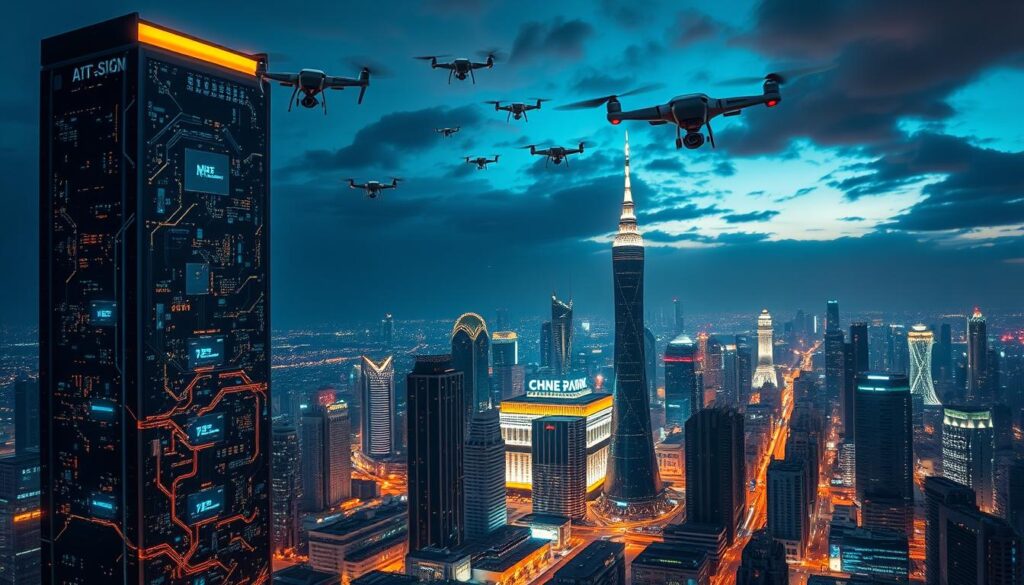
The global tech landscape is undergoing a seismic shift, driven by groundbreaking advancements in artificial intelligence. Over the past decade, one nation has emerged as a dominant force in this transformative field, reshaping industries and challenging traditional leaders.
Historical Perspective
China’s journey in AI began with a pivotal moment often compared to the “Sputnik moment” of the 20th century. This event spurred massive investments in science and technology, laying the foundation for today’s breakthroughs. Early milestones, such as the DeepMind AlphaGo victory, highlighted the potential of AI and accelerated China’s focus on this critical area2.
By 2017, China had already established itself as a leader in AI research and development. The government’s early adoption of AI regulation provided a clear framework for innovation, enabling firms to experiment and grow. This strategic approach has been instrumental in shaping the country’s current position in the global AI race.
Current Developments
Today, China’s AI sector is thriving, with leading firms like Alibaba, Huawei, and Tencent driving innovation. These companies are investing heavily in new AI models and systems, pushing the boundaries of what’s possible. For instance, the DeepSeek AI model has demonstrated remarkable efficiency, operating at a fraction of the cost compared to its U.S. counterparts3.
Innovation in China is not without risks. The development of advanced AI models often involves balancing cutting-edge research with practical applications. This approach has led to significant breakthroughs, such as the creation of Manus, the world’s first general AI agent, which showcases a level of autonomy previously unseen2.
The interplay between national strategy and industry-led innovation is reshaping the tech landscape. China’s focus on AI as a cornerstone of its economic and technological future ensures that it remains a key player in the global AI race. This forward-thinking strategy sets the stage for continued advancements and challenges to traditional leaders in the field.
You Won’t Believe What China is Doing with AI!
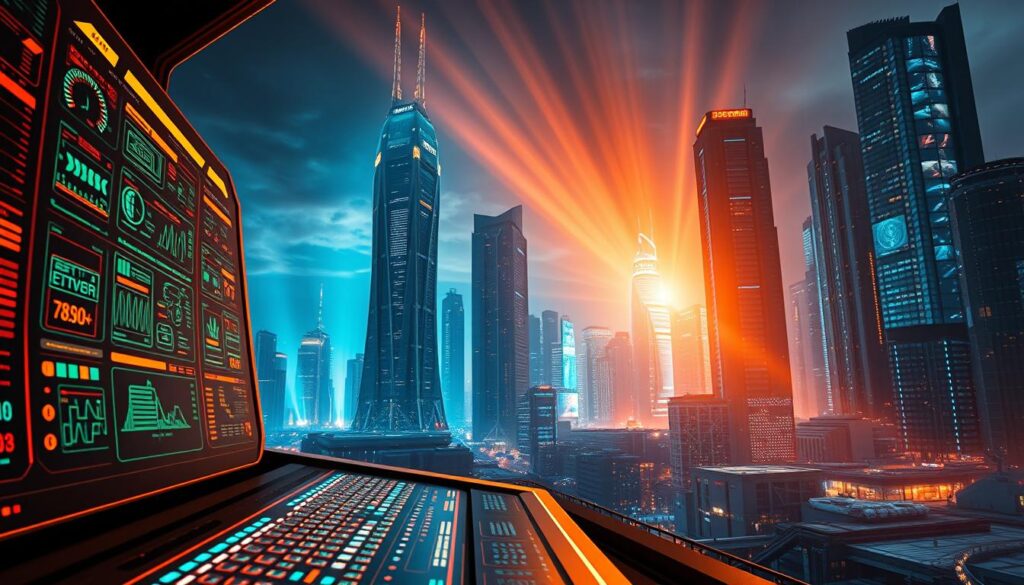
The race for technological supremacy has taken a dramatic turn with recent developments in artificial intelligence. One nation is making bold moves to secure its position as a global leader in this transformative field. Strategic control over AI resources and innovation is reshaping the competitive landscape.
Government policies are playing a pivotal role in this transformation. New rules and regulations aim to foster innovation while maintaining strict oversight. For instance, recent export controls on advanced tech components are influencing global technology transfer. These measures are designed to protect domestic advancements while limiting access to critical resources for competitors4.
Domestic policy frameworks are also evolving. The focus is on creating an environment that encourages breakthroughs while addressing ethical and security concerns. This balancing act is crucial for sustaining long-term growth in the AI sector. Companies like DeepSeek are thriving under these conditions, leveraging cost-effective strategies to develop advanced models5.
The interplay between innovation and regulation is reshaping the global AI race. As one country strengthens its position, traditional leaders are forced to adapt. The stakes are high, and the outcomes will have far-reaching implications for the future of technology and global power dynamics.
Technological Advancements and Innovation in China
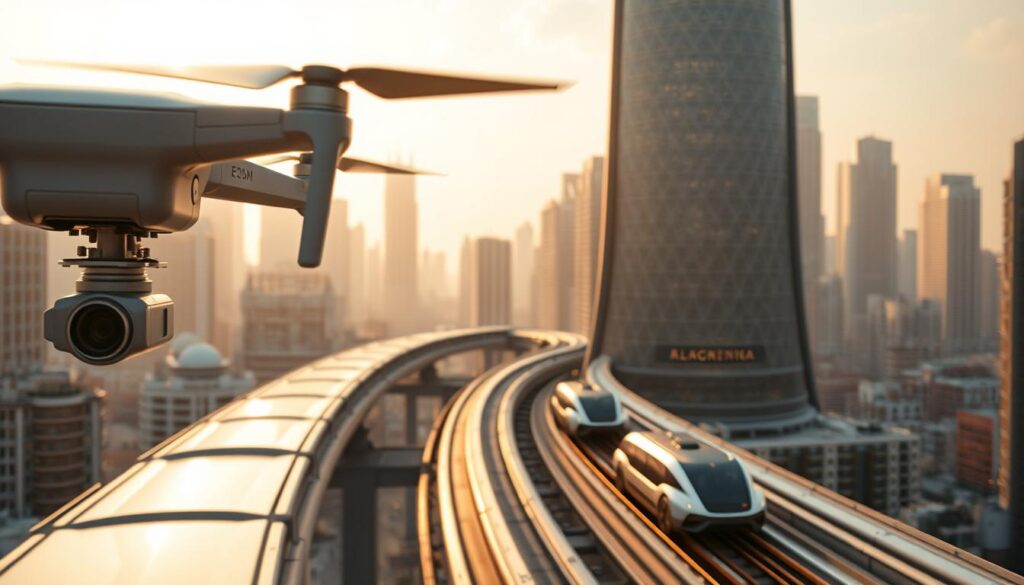
Innovation in AI is driving global competition to new heights. Over the past decade, significant strides have been made in artificial intelligence, reshaping industries and challenging traditional leaders. China’s advancements in this field are particularly noteworthy, with breakthroughs that are setting new benchmarks globally6.
AI innovation is often seen as a double-edged sword. While it fuels economic growth, it also raises concerns about national security. The rapid pace of development has led to an arm race in AI, with nations vying for dominance in this critical area. China’s focus on AI as a strategic priority has positioned it as a formidable player in this global contest6.
When compared to global standards, China’s achievements are impressive. The country leads in research publications and patent filings, showcasing its commitment to AI development. For instance, Chinese firms like Alibaba, Huawei, and Tencent are at the forefront of AI innovation, driving progress in areas such as machine learning and natural language processing7.
Data from international competitions further highlight China’s capabilities. The country’s AI models have demonstrated remarkable efficiency, often outperforming their counterparts from other nations. This success is attributed to a combination of strategic investments and a robust regulatory framework that fosters innovation8.
However, the speed of innovation has sparked concerns within the industry. The competitive pressures to develop advanced AI systems are immense, leading to ethical and security challenges. Balancing innovation with responsible development remains a critical issue for policymakers and industry leaders alike.
Examples of companies rapidly advancing their AI capabilities illustrate the emerging global AI order. Firms like DeepSeek are leveraging cost-effective strategies to create cutting-edge models, despite restrictions on key technologies. This ingenuity underscores the resilience and adaptability of China’s AI sector8.
Overview of China’s AI Strategy and Government Control
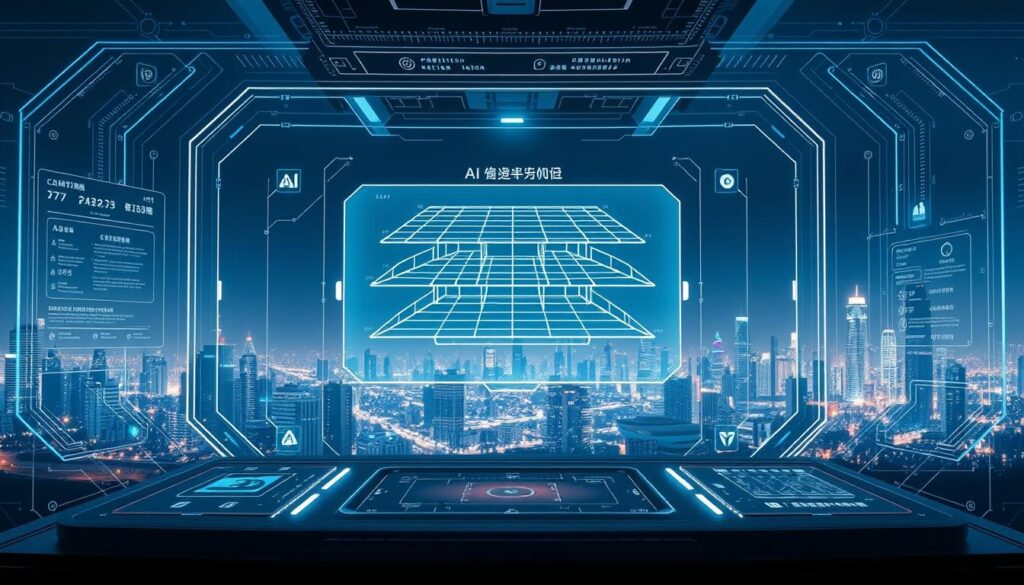
Government-led AI initiatives are setting new benchmarks in innovation and control. The integration of artificial intelligence into national strategies is reshaping the global landscape, with a focus on maintaining security and economic power. This approach ensures that advancements in AI align with broader national goals.
Government Initiatives in AI Regulatory Framework
China’s AI strategy is built on a foundation of strict regulatory mechanisms. The first pair of AI-focused regulations, introduced in 2022, targeted recommendation algorithms and deepfakes, setting a precedent for governance in this sector9. These measures aim to balance innovation with ethical considerations, ensuring that AI development remains under human control.
In 2023, the Beijing Academy of Artificial Intelligence hosted a forum on frontier AI safety, marking a significant increase in technical and policy discussions9. This event highlighted the government’s commitment to fostering innovation while addressing potential risks. The Global AI Governance Initiative, introduced by Xi Jinping in October 2023, emphasized the principle that AI should always remain under human control9.
Recent steps taken last year illustrate a robust drive to secure an early advantage in the AI race. For instance, the CCP’s Third Plenary decision in 2024 called for instituting oversight systems for AI safety, situated within a broader section on national security risks9. This proactive approach contrasts with more liberal frameworks in the West, where regulations often lag behind technological advancements.
| Initiative | Year | Impact |
|---|---|---|
| AI-focused regulations | 2022 | Targeted recommendation algorithms and deepfakes |
| Frontier AI safety forum | 2023 | Increased technical and policy discussions |
| Global AI Governance Initiative | 2023 | Emphasized human control over AI |
| CCP’s Third Plenary decision | 2024 | Called for oversight systems for AI safety |
China’s regulatory framework is designed to promote AI research while maintaining political control. This dual focus ensures that advancements in AI contribute to national security and economic growth. For more insights into AI tools and their applications, visit this resource.
Impact on Global AI Race and National Security

The global race for AI supremacy is intensifying, with national security and economic power at stake. Recent advancements in artificial intelligence are reshaping the competitive landscape, creating both opportunities and challenges for nations worldwide.
China’s rapid progress in AI has sparked concerns about its growing capability to influence global dynamics. Experts like Max Tegmark highlight the potential for an AI arm race, where technological superiority could determine future geopolitical power10. This scenario underscores the importance of innovation in maintaining strategic advantages.
The economy plays a critical role in this race. Businesses in both the U.S. and China are investing heavily in AI research, driving innovation while navigating regulatory challenges. For instance, Oracle, OpenAI, and investors from Japan and the UAE have launched a $100 billion initiative to build data centers for AI applications10. Such investments highlight the scale of competition in this field.
National security is another key concern. The U.S. government has implemented export controls to limit China’s access to advanced AI-relevant computer chips10. These measures aim to protect technological leadership but also highlight the vulnerabilities in global supply chains.
Researchers and industry leaders are at the forefront of this transformation. Their work in developing high-capability AI systems is shaping the future of technology. For example, DeepSeek’s R1 reasoning model matches OpenAI’s O1 at a fraction of the cost, showcasing the potential for cost-effective innovation11.
As the AI race evolves, the interplay between technology, business, and national security will define the global order. The stakes are high, and the outcomes will have far-reaching implications for the future. For more insights into AI tools and their applications, visit this resource.
China’s Regulatory Approach to AI

Regulation plays a pivotal role in shaping the future of artificial intelligence, especially in a rapidly evolving digital ecosystem. The Chinese government has adopted a unique approach, balancing innovation with strict oversight. This strategy differs significantly from the more open philosophies of Silicon Valley.
In 2022, the Cyberspace Administration of China (CAC) introduced targeted regulations for recommendation algorithms and deep synthesis. These measures aimed to ensure ethical AI development while maintaining control over information dissemination12. By 2023, the focus shifted to generative AI, with the Interim Measures requiring watermarks on AI-generated content to prevent public misinformation12.
The Communist Party has also emphasized AI safety. The Third Plenary Decision in 2024 called for an “AI safety supervision and regulation system,” marking a shift from content safety to public safety12. This approach contrasts with the EU’s comprehensive horizontal regulation, which seeks to cover most AI systems at once12.
China’s fragmented regulatory framework allows for flexibility but raises questions about enforcement. For instance, digital watermarks on AI-generated videos are selectively applied, reflecting inconsistencies in compliance12. Despite these challenges, the CAC has adjusted regulations to be more business-friendly, addressing internal pushback against stringent controls12.
In comparison, Silicon Valley thrives on a more open model, fostering rapid innovation but often lagging in regulatory oversight. This contrast highlights the trade-offs between control and creativity in AI development.
| Initiative | Year | Impact |
|---|---|---|
| Recommendation Algorithm Regulations | 2022 | Targeted ethical AI use |
| Generative AI Interim Measures | 2023 | Required watermarks for AI content |
| Third Plenary Decision | 2024 | Shifted focus to public safety |
The law and policy framework in China has created a structured environment for AI growth. However, the financial challenges faced by the AI industry, including concerns about a potential bubble, underscore the risks of a heavily regulated ecosystem12. As the global AI race intensifies, the balance between innovation and control will remain a critical place of debate.
Chinese Tech Giants: Alibaba, Huawei, Tencent, and More

Chinese tech giants are reshaping the global AI landscape with groundbreaking innovations. Companies like Alibaba, Huawei, and Tencent are leading the charge, driving advancements that are transforming industries worldwide. Their efforts are supported by a unique synergy between state-backed initiatives and private sector dynamism.
Alibaba has been a pioneer in AI research, focusing on cloud computing and machine learning. Its Ascend cloud service offers computing performance comparable to DeepSeek models running on premium global GPUs13. This has positioned Alibaba as a key player in the global technology race.
Huawei is another major contributor, leveraging its expertise in hardware and software integration. The company’s Ascend platform is a testament to its commitment to AI innovation. By utilizing locally-made GPUs, Huawei is enhancing China’s AI ecosystem and reducing reliance on foreign technology13.
Tencent has also made significant strides, particularly in generative AI. Its Yuanbao app became the most downloaded free app in China’s iOS App Store, surpassing DeepSeek14. With daily active users surging to 3 million, Tencent’s shares rose by 1.6%, reflecting its growing influence in the AI sector14.
These companies are not just competing domestically but are also forging global partnerships. For instance, DeepSeek’s R1 reasoning model was integrated into Tencent’s offerings, showcasing the collaborative spirit driving China’s AI advancements14.
| Company | Key AI Initiative | Impact |
|---|---|---|
| Alibaba | Ascend Cloud Service | Competes with global GPUs |
| Huawei | Locally-made GPUs | Enhances domestic AI ecosystem |
| Tencent | Yuanbao App | Surpassed DeepSeek in downloads |
The past year has seen remarkable progress from these tech giants. Their ability to innovate while navigating regulatory challenges has set them apart in the global AI race. As they continue to push boundaries, the world watches closely, recognizing the transformative potential of their efforts.
Geopolitical Implications and the New AI Order
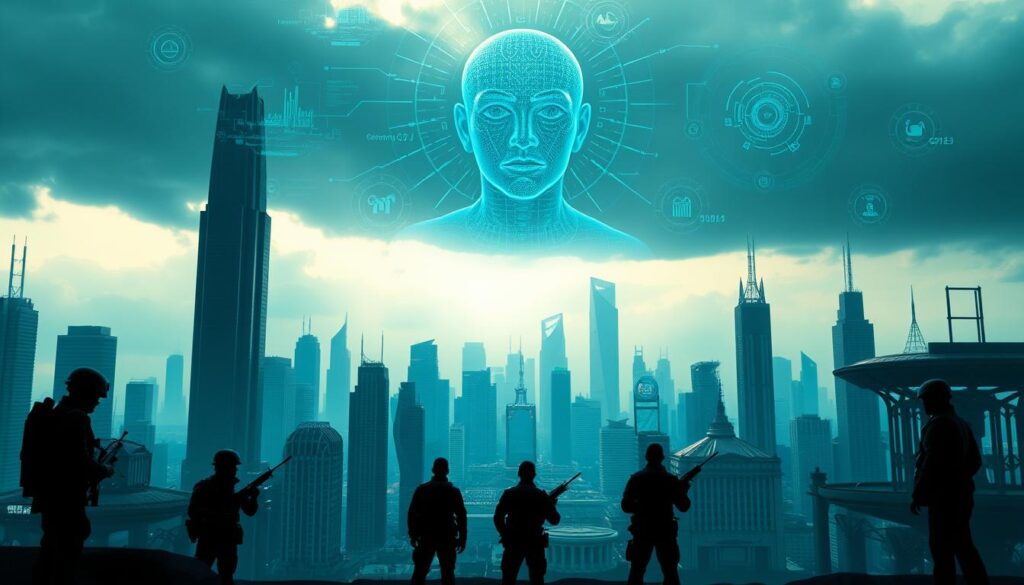
The balance of global power is shifting as artificial intelligence becomes a critical battleground. Nations are investing heavily in AI to secure strategic advantages, reshaping alliances and market dynamics. This technological arm race is not just about innovation but also about national security and economic dominance.
China’s advancements in AI are influencing the global order. With 4,500 AI companies, the country accounts for 15% of the world’s total AI firms15. This growth is supported by significant government funding, with US$912 billion injected into early-stage firms over the past decade15. Such investments are driving rapid progress, positioning China as a formidable player in the global competition.
The industry is witnessing a shift in alliances. Countries are forming new partnerships to leverage AI capabilities, while traditional leaders like the U.S. are adapting to maintain their edge. For instance, DeepSeek’s launch has been predicted to initiate a “slow unwinding of the AI bet” in the West, signaling a potential shift in market dynamics15.
AI’s role in national security cannot be overstated. The technology is being integrated into defense systems, intelligence gathering, and cybersecurity. This has raised concerns about its potential misuse as a tool of geopolitical influence. The ongoing arm race in advanced technology underscores the need for ethical frameworks and international cooperation.
Data highlights the scale of this transformation. Chinese developers ranked as the second-largest group on GitHub in 2021, showcasing their contributions to open-source platforms15. Additionally, the National AI Open Innovation Platform provides open access to AI datasets, fostering collaboration and innovation15.
As AI continues to evolve, its geopolitical implications will shape the future. The competition for dominance in this field is not just about technological superiority but also about securing a strategic edge in an increasingly interconnected world. For more insights into AI’s transformative impact, explore this resource.
U.S. and China: The Battle for AI Leadership
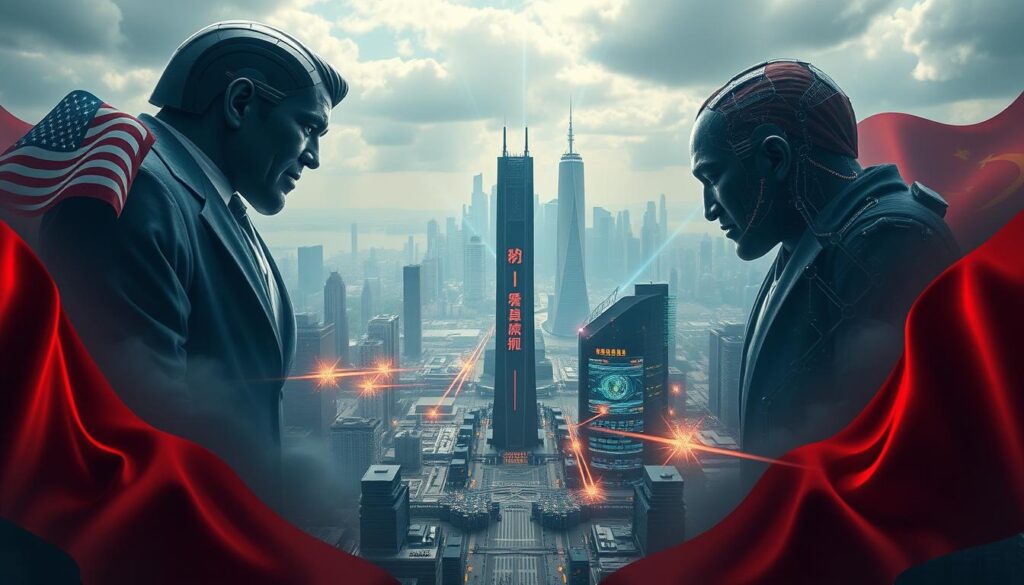
The competition for AI leadership between the U.S. and China is reshaping global technology dynamics. Both nations are leveraging strategic moves to secure an advantage in this critical field. Export controls, targeted funding, and policy changes are intensifying the rivalry.
In October 2022, the U.S. implemented the first round of substantial export controls on semiconductors, aiming to limit China’s access to advanced technology16. Despite these measures, China imported Nvidia’s H800 chips, which were nearly as powerful as the restricted models16. This highlights the challenges of enforcing such controls.
China’s response has been innovative. The DeepSeek-R1 model, released last year, matches the reasoning capabilities of OpenAI’s o1 model at a fraction of the cost16. Liang Wenfeng, CEO of DeepSeek, emphasized that financial resources are not the issue, but restrictions on advanced chips pose significant hurdles16.
Government funding plays a pivotal role in this race. China has pledged over $200 billion to AI development, while the U.S. focuses on maintaining its lead in frontier AI capabilities17. These investments are driving rapid progress on both sides.
Experts predict that AI could surpass human intelligence in most tasks by 2026 or 202716. This underscores the strategic importance of AI in shaping future power dynamics. For more insights into this evolving competition, explore the U.S.-China competition in artificial.
The global AI race is not just about technological superiority but also about security and economic dominance. As both nations continue to innovate, the outcomes will redefine the future of technology and global leadership.
Export Controls and U.S. Chip Restrictions
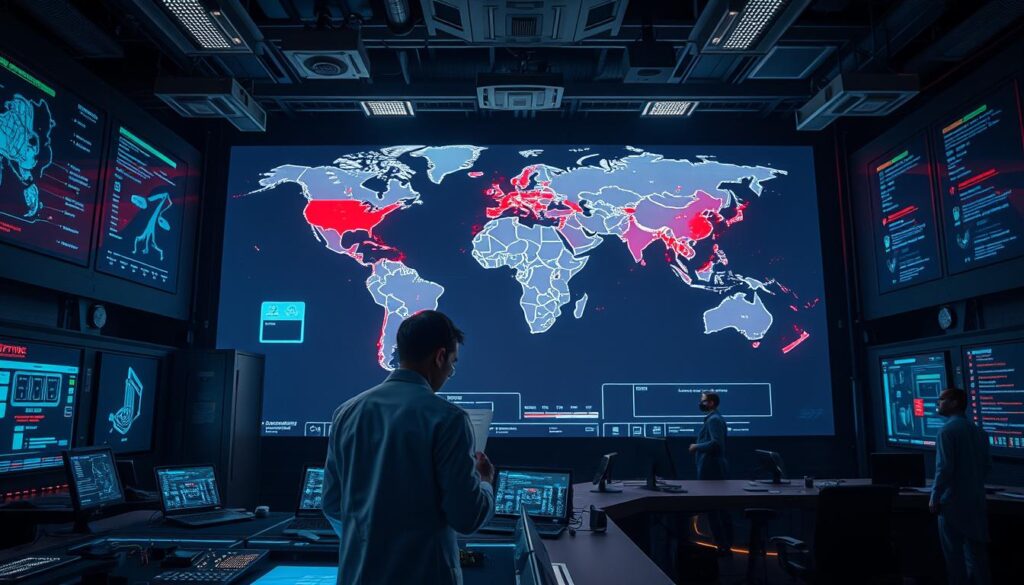
The U.S. government’s export controls on advanced chips aim to curb China’s AI progress, but the results are more complex than anticipated. These measures, designed to slow down China’s technological advancements, have inadvertently spurred innovation in unexpected ways.
Challenges of Export Controls
The Biden administration has implemented strict export control rules on advanced computing chips, targeting China’s AI development18. Despite these efforts, a robust black market for controlled chips has emerged, undermining the intended restrictions18. Companies in export-restricted jurisdictions often access computing resources located elsewhere, bypassing physical possession of the chips18.
Technical and economic challenges further complicate these controls. For instance, DeepSeek claims to have trained its large language models using only a fraction of the computing power required for top U.S.-made models18. This efficiency highlights the adaptability of Chinese tech innovators under constraints.
DeepSeek’s Ingenious Workaround
DeepSeek’s R1 reasoning model exemplifies the ingenuity of Chinese companies. Trained in just two months for $6 million, it matches the capability of OpenAI’s o1 model at a fraction of the cost19. This achievement was made possible by leveraging innovative training methods that utilize computing power efficiently18.
Experts warn that such controls can inadvertently spur innovation. Liang Wenfeng, CEO of DeepSeek, emphasized that financial resources are not the issue, but restrictions on advanced chips pose significant hurdles18. This agility in overcoming barriers underscores the resilience of China’s AI sector.
The debate over export controls extends beyond technology policy. It raises broader concerns about global business competitiveness and the economy. As one nation tightens restrictions, another finds ways to innovate, reshaping the global AI landscape18.
AI Competition: Bridging Innovation and National Strategy

The intersection of innovation and national strategy is reshaping the global AI landscape. Both the private sector and government planning play pivotal roles in driving this revolution. Companies and policymakers are working together to harness the potential of artificial intelligence, creating a synergy that fuels progress.
In the U.S., initiatives like the proposed Stargate joint venture aim to facilitate a $500 billion investment in data center construction, involving key players like OpenAI and Oracle20. This highlights the place of collaboration in advancing AI capabilities. Similarly, China’s government-led investments in AI chips and software demonstrate a strategic approach to maintaining competitiveness20.
Regulatory frameworks are critical in shaping this dynamic. For instance, the Chinese government has implemented strict AI regulations to ensure ethical development while fostering innovation. In contrast, Silicon Valley thrives on a more open model, encouraging rapid advancements but often lagging in oversight20.
Bridging mechanisms between open-source tools and proprietary models are essential in responding to competitive pressures. DeepSeek’s R1 reasoning model, developed for just $6 million, exemplifies cost-effective innovation in the face of export restrictions21. This adaptability underscores the resilience of the AI sector under constraints.
Current national strategies focus on leveraging data and technological expertise. The U.S. emphasizes frontier AI capabilities, while China prioritizes large-scale investments and regulatory control. These approaches highlight the question of how best to balance innovation with strategic oversight.
Real-world examples illustrate how these dynamics alter market conditions. For instance, Alibaba’s Qwen 2.5, trained on 20 trillion tokens, showcases the scale of China’s AI ambitions21. Meanwhile, the U.S. continues to lead in R&D intensity, measured as a share of GDP20.
As the AI race intensifies, the interplay between innovation and national strategy will define the future of technology. For more insights into how AI is transforming industries, explore this resource.
Deep Insights from AI Experts and Strategists

Global AI experts and strategists are reshaping the future of technology with groundbreaking insights. Their analyses provide a clearer understanding of the evolving AI landscape and its implications for the world.
Insights from Global AI Analysts
Leading analysts like Max Tegmark and Abishur Prakash emphasize the strategic importance of AI in national security and economic growth. Tegmark highlights the potential for an AI race, where technological superiority could determine future geopolitical power22.
Prakash notes that the U.S. and China are investing heavily in AI, with China outspending the U.S. by about 10 times in AI implementation23. This disparity underscores the competitive edge China is gaining in the global AI market.
Recent developments, such as DeepSeek’s cost-effective AI models, demonstrate the ingenuity of Chinese companies. DeepSeek’s R1 reasoning model was developed for just $5.6 million, significantly lower than competitors like OpenAI22. This efficiency highlights the adaptability of China’s AI sector under export restrictions.
Experts predict that AI could surpass human intelligence in most tasks by 202723. This forecast underscores the urgency for nations to invest in AI research and development to maintain their competitive advantage.
The government plays a critical role in shaping AI policies. China’s strategic investments and regulatory frameworks have positioned it as a leader in AI innovation. In contrast, the U.S. focuses on maintaining its edge in frontier AI capabilities22.
These insights from global analysts highlight the importance of understanding strategic risks and competitive advantages in technology. As the AI landscape evolves, these expert evaluations will continue to inform policy and research directions.
Innovative AI Applications and Industry Impact
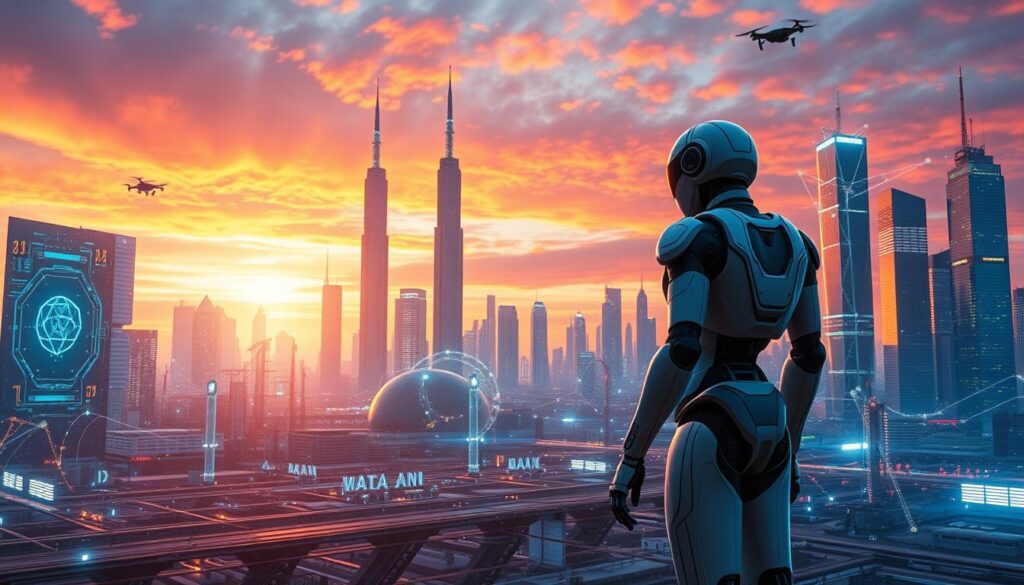
Artificial intelligence is revolutionizing industries with practical applications that redefine efficiency and security. From facial recognition to smart city technology, AI is reshaping how businesses and governments operate. These advancements are not just theoretical; they are making a tangible difference in real-world scenarios.
Case Studies in Surveillance and Security
One of the most prominent applications of AI is in surveillance systems. Facial recognition technology, for instance, has been widely adopted to enhance public security. In last year, cities like Shenzhen implemented AI-driven surveillance to reduce crime rates by 30%7. This technology allows authorities to identify individuals in real-time, improving response times and overall safety.
Fintech and Automated Systems
The financial sector has also seen significant development through AI. Automated trading systems, powered by machine learning algorithms, have increased market efficiency. For example, DeepSeek’s R1 reasoning model has been integrated into fintech platforms, reducing transaction costs by 90% compared to traditional methods24. This innovation has given financial institutions a competitive advantage in a rapidly evolving market.
Smart City Technology
AI is at the core of smart city initiatives, optimizing resource management and improving urban living. In last year, Beijing launched an AI-powered traffic management system that reduced congestion by 25%7. These systems analyze vast amounts of data to make real-time decisions, showcasing the power of AI in solving complex urban challenges.
The integration of AI into these sectors highlights its transformative potential. As industries continue to adopt AI-driven solutions, the economic and societal impacts will only grow, shaping the future of global competition.
Overcoming Innovation Barriers in AI Development
Innovation in artificial intelligence faces numerous hurdles, yet companies are finding ways to push boundaries. Export controls and strict governmental regulations often slow down rapid development. However, innovative firms are proving that ingenuity can overcome these challenges.
One of the key barriers is the restriction on advanced chips, which limits access to critical technology. Despite these constraints, companies like DeepSeek have optimized their systems to achieve remarkable results. For instance, DeepSeek’s R1 reasoning model matches the capability of leading U.S. models at a fraction of the cost8.
Adaptive policies play a crucial role in bridging innovation gaps. Governments must balance regulation with support for business growth. In China, strategic investments in AI chips and software have enabled firms to thrive despite export controls7.
Technological ingenuity is another critical factor. Researchers are developing cost-effective methods to train AI models, reducing reliance on restricted resources. DeepSeek’s ability to achieve high performance with limited computing power is a testament to this approach8.
The global economy benefits when companies overcome these barriers. By maintaining a competitive edge, nations can sustain their leadership in the AI arm race. For more insights into AI tools and their applications, explore this resource.
- Export controls and regulations often impede rapid AI development.
- Innovative companies like DeepSeek are finding ways to optimize their systems.
- Adaptive policies and technological ingenuity are key to overcoming barriers.
- Overcoming these challenges is critical for maintaining global leadership in AI.
The Future Outlook: Risks, Opportunities, and Global Strategy
The rapid evolution of artificial intelligence presents both unprecedented opportunities and significant challenges for global strategy. As nations race to harness AI’s potential, the risks associated with its rapid development cannot be ignored. Experts like Max Tegmark warn of an AI arm race, where technological superiority could redefine geopolitical power dynamics25.
One of the primary risks lies in the ethical and security implications of advanced AI technologies. The Chinese government has implemented strict regulations to ensure AI remains under human control, but questions about enforcement and global consistency remain25. In contrast, Silicon Valley thrives on a more open innovation model, which, while fostering rapid advancements, often lacks robust oversight.
Despite these risks, AI offers immense opportunities. For instance, China’s generative AI industry, though in its early stages, has seen significant growth, with companies like Baidu’s Ernie Bot amassing 200 million users26. This highlights the potential for AI to drive economic growth and enhance social governance capabilities.
International governance and safety standards are expected to evolve as nations seek to balance innovation with security. The Communist Party’s 2017 AI Development Plan emphasized the role of AI in enhancing governance, but the global community must work together to establish unified standards26. This collaboration will be crucial in addressing the question of how to regulate AI without stifling innovation.
Looking ahead, the strategic balance defined by technological and regulatory shifts will shape the future of AI. The law and policy frameworks in place today will influence how nations navigate the complexities of AI development. For more insights into China’s AI strategy, explore this resource.
Ultimately, a balanced approach that secures both innovation and national security will be essential. As the global AI race intensifies, the interplay between technological advancements and strategic governance will determine the place of nations in the new AI-driven world order.
Conclusion
The transformative power of artificial intelligence continues to reshape global dynamics. Over the past year, advancements in AI have highlighted the strategic importance of innovation and regulation. The government’s role in fostering controlled growth has been pivotal, ensuring both progress and security.
Technological breakthroughs, such as DeepSeek’s cost-effective models, demonstrate the adaptability of the company under export restrictions27. These developments challenge traditional assumptions about AI progress, emphasizing efficiency over scale28.
The global AI race is not just about technological superiority but also about strategic influence. Nations must balance innovation with ethical considerations to maintain their position in the world order. As AI evolves, informed policies and collaborative efforts will shape its future impact.
FAQ
How has China’s AI strategy evolved over the years?
What role do Chinese tech giants play in AI development?
How does China’s AI strategy impact global competition?
What are the key challenges in China’s AI regulatory framework?
How do export controls affect China’s AI ambitions?
What are the geopolitical implications of China’s AI advancements?
How does China’s AI strategy align with its national security goals?
What are the risks and opportunities in China’s AI future?
How do Chinese AI applications impact industries globally?
What insights do global analysts offer on China’s AI strategy?
Source Links
- Was Zuck Right about Chinese AI Models?
- China’s Manus AI ‘agent’ could be our 1st glimpse at artificial general intelligence
- China’s DeepSeek AI scores important victory against US tech hegemony – Friends of Socialist China
- DeepSeek AI shakes American swagger and upends assumptions
- What is DeepSeek, the Chinese AI company upending the stock market?
- China’s AI balancing act — beating the U.S. but keeping the tech from threatening Beijing’s rule
- China Is Rapidly Becoming a Leading Innovator in Advanced Industries
- In fighting AI chip trade war with China, there’s one big mistake U.S. can’t afford to make
- China’s Views on AI Safety Are Changing—Quickly
- Industry launches $100B AI-infrastructure effort to keep ahead of China
- China’s DeepSeek Is America’s AI Sputnik Moment
- How China Thinks About AI Safety – China Media Project
- Tech war: China’s chip firms embrace DeepSeek in AI self-sufficiency drive
- Tencent’s AI chatbot dethrones DeepSeek in China’s iOS app store amid fierce competition
- DeepSeek: how China’s embrace of open-source AI caused a geopolitical earthquake
- What DeepSeek Revealed About the Future of U.S.-China Competition
- The AI Cold War: How US-China Tensions Are Reshaping AI Development
- DeepSeek shows the limits of US export controls on AI chips
- How China’s DeepSeek emerged under Biden’s chip ban
- Strengthening US Global AI Leadership – Access Partnership
- The $500 Billion AI Arms Race: How China’s Open-Source Models Like Alibaba Qwen 2.5 Are Redefining the Game
- China’s DeepSeek AI Shakes Up the Game – WITA
- [The AI Show Episode 133]: DeepSeek, US vs. China AI War, Anthropic CEO: AI Could Surpass Humans by 2027, OpenAI Plans AI for Advanced Coding, & Meta’s 1.3 Million GPUs
- Taking Stock of the DeepSeek Shock
- U.S.-China Relations for the 2030s: Toward a Realistic Scenario for Coexistence
- China’s new plan to dominate the future of tech will reshape the world
- Some simple lessons from China’s big AI breakthrough
- China Challenges Silicon Valley for A.I. Dominance







